This week, the Bitcoin market exhibited a wide range of fluctuations, initially showing narrow consolidation, followed by intense long-short battles, with significant market volatility.
Written by: Monkey
1. Bitcoin Market
From July 19 to July 25, 2025, the specific movements of Bitcoin were as follows:
July 19: Bitcoin's price began the morning with a downward trend, fluctuating from $117,930 down to $117,073 before rebounding, rising to $117,912 and starting a period of oscillation, peaking at $118,426 before weakening. In the evening, it briefly fell to $117,721 but stabilized again, closing at $118,113, with a relatively balanced force between buyers and sellers.
July 20: Bitcoin showed a narrow range of oscillation with a slight upward bias. After opening, it dipped slightly to the day's low of $117,544, then entered a typical stair-step upward structure, gradually climbing and breaking through $118,117 and $118,287, ending the day further up at $118,731, indicating a strengthening intention from the bulls.
July 21: Continuing the upward momentum from the previous day, Bitcoin rose to $118,778 before experiencing a technical pullback, quickly rebounding to around $118,557. However, the market suddenly saw a significant drop, hitting a low of $116,914, followed by a rapid V-shaped reversal driven by strong buying, with the price not only recovering to $118,644 but also briefly breaking through $119,605. Although it could not stabilize at that high, it fell back to $118,016 but then surged again to $119,072, ultimately closing at $118,377, with intense volatility and fierce long-short battles, reflecting turbulent short-term market sentiment.
July 22: The price continued the high volatility from the previous day, starting the morning down from $117,473, hitting a low of $116,762 before rebounding. For a period, it showed a trend of oscillating upward, recovering to $117,804 before testing a low of $116,639, forming a double bottom structure and gaining effective support. In the afternoon, Bitcoin regained its upward momentum, oscillating upward and successfully breaking through the $119,000 mark, peaking at $119,429. Although it experienced a brief pullback in the evening, the bulls quickly took over, maintaining a strong stance, and ultimately closed at $118,956, indicating an increase in bullish sentiment in the market.
July 23: Continuing the strong trend from the previous trading day, Bitcoin rose continuously after opening, reaching a high of $120,204, marking a recent peak. However, it failed to break through this key psychological level effectively, gradually retreating to $117,915. Subsequently, there was fierce competition between bulls and bears, with the price oscillating and hitting a low of $117,474, indicating intense contention in the high price area.
July 24: Bitcoin continued its wide range of oscillation at high levels, with frequent shifts in the forces of bulls and bears throughout the day. In the morning, the price consolidated between $117,500 and $118,700, then the bulls pushed the price upward, forming a brief consolidation near $119,000, peaking at $119,274. However, after reaching this peak, it faced rapid selling pressure, quickly dropping to a low of $117,523. The market then staged a strong rebound, setting a new intraday high of $119,373 before slightly pulling back before the close, maintaining a pattern of intense oscillation, indicating significant divergence between bulls and bears within the current range.
July 25: Bitcoin maintained the high volatility from the previous trading day, continuing its rebound momentum in the morning, with the price rising to a high of $119,398. However, this level became a short-term resistance again, and the market shifted into a downward channel, quickly retreating to around $117,850, completely giving back the short-term gains. As of the time of writing, Bitcoin was reported at $117,859, still within the oscillation range. Overall, the price remains in the oscillation consolidation area between $117,500 and $119,500, and without a strong breakout, the oscillation pattern is expected to continue, with short-term trading needing to be cautious of sudden reversal risks.
Summary
This week, Bitcoin's overall trend exhibited a wide range of oscillation, initially showing narrow sideways consolidation, followed by intense long-short battles at high levels, with significant market volatility.
Specifically, from July 19 to 20, the price oscillated around the $118,000 line, with limited fluctuations, typical of a consolidation phase. Starting from July 21, market volatility increased, with Bitcoin's price frequently experiencing rapid surges and deep pullbacks, showing a clear wide range of oscillation. During this period, it made several attempts to break through the $119,000 and $120,000 levels but failed to achieve effective breakthroughs, indicating heavy selling pressure above. Meanwhile, support below also remained strong, with a quick rebound after a low of $116,639, indicating that bulls were actively buying below key support levels, leading to intense market competition.
The highest point during the week was $120,204, and the lowest was $116,639, with a volatility range of 3.06%. Technically, the high-level oscillation pattern has not been broken, and the short-term outlook remains biased towards oscillation. Attention should be focused on the breakout situation in the $119,000 to $120,000 resistance range and the effectiveness of support in the $117,500 to $116,500 area, as future movements may depend on changes in trading volume and macro news.
Overall, although Bitcoin did not achieve a clear breakout this week, bullish momentum has shown signs, and if there is a strong breakout above key resistance levels in the future, a new trend may emerge. Conversely, if it falls below key support areas again, a deeper adjustment phase cannot be ruled out.
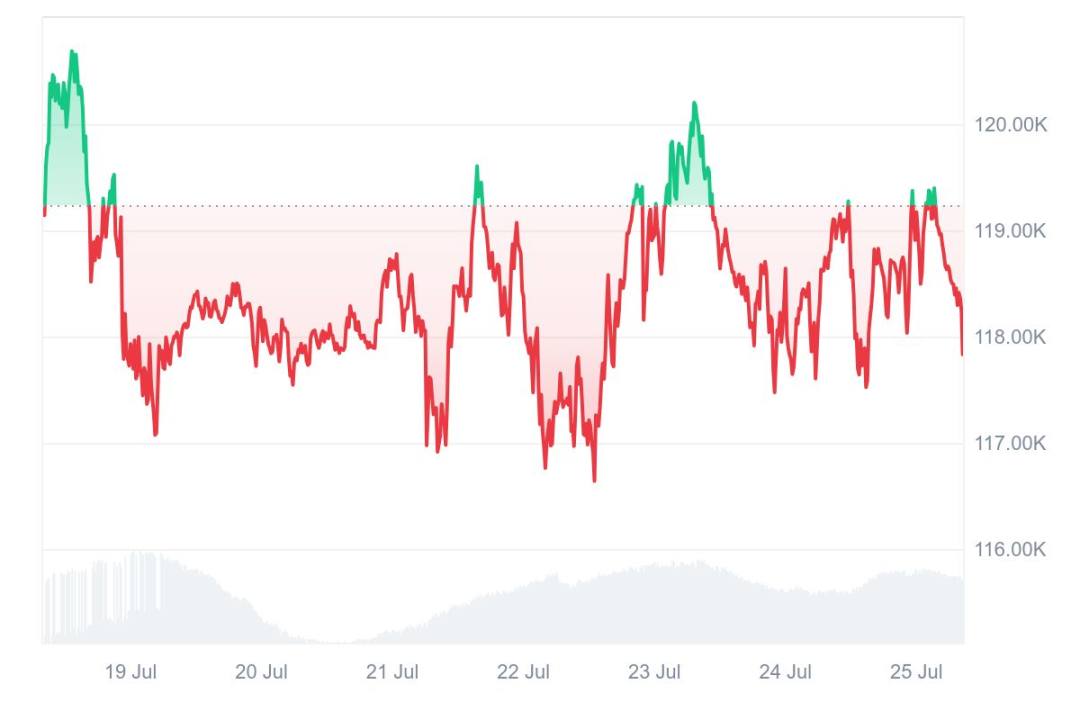
Bitcoin Price Trend (2025/07/19-2025/07/25)
2. Market Dynamics and Macroeconomic Background
Capital Flow
1. Market funds flowing into altcoins, Bitcoin's market share declines
According to market data, Bitcoin's market dominance (BTC Dominance) has declined for eight consecutive days, dropping to 61.15% as of July 20, below the annual high of 61.53% in 2024. The continued decline in Bitcoin's market share indicates that the "altcoin season" is gradually beginning.
On July 22, Coingecko data showed that Bitcoin's market share further dipped to 58.5%, primarily driven by the strong performance of mainstream altcoins like Ethereum (ETH) and Ripple (XRP): ETH rose 25.0% over seven days, XRP increased by 20.4%, and SOL and BNB rose by 15.4% and 10.2%, respectively.
Crypto analyst @DaanCrypto pointed out that in the past month, most of the top 100 altcoins by market capitalization have outperformed Bitcoin, which is the core driver of the decline in market share.
2. Miners and whales significantly sell off, exchange BTC inflows hit a new high for the phase
As Bitcoin's price climbed to historical highs, on-chain data showed large-scale sell-offs occurring simultaneously:
On July 15, the daily inflow of Bitcoin to exchanges surged to 81,000 BTC, the highest since February.
Among them, the inflow of whale transactions over 100 BTC increased from 13,000 BTC to 58,000 BTC.
During the same period, miners transferred out 16,000 BTC, almost all of which flowed into exchanges.
Ethereum also showed a similar trend: on July 16, 2 million ETH flowed into exchanges, the highest since the end of February this year, indicating a significant rise in short-term profit-taking sentiment in the market.
3. Various holding entities restart coin hoarding mode, funds shift to on-chain accumulation
Despite the increased short-term volatility in the market, on-chain data shows that various types of coin holders have returned to "hoarding" behavior. A report from Glassnode on July 21 indicated that from small investors to large whales, almost all wallet size groups have re-entered the "perfect hoarding mode." The on-chain activity of whale wallets has returned to levels seen in December 2024, indicating strong confidence in the medium to long-term market outlook.
4. Long-term holders' on-chain distribution increases, but it is difficult to change the trend of net capital inflow in the medium to long term
On July 24, CryptoQuant analyst Axel Adler Jr pointed out that Bitcoin is currently experiencing an unusually high monthly capital destruction degree (CDD) / annual CDD ratio, reaching 0.25, comparable to levels seen at the 2014 peak and during the 2019 correction period, reflecting that long-term holders (LTH) are reactivating BTC that has been dormant for years in preparation for sale.
This phenomenon indicates that experienced investors in the market (especially long-term holders) are actively distributing their holdings; the bullish trend is facing a certain degree of "internal distribution resistance"; and the current price level has triggered profit-taking behavior from some early holders.
However, Axel emphasized that despite the selling pressure from LTH behavior, the continuous capital inflow into U.S. ETFs (see Section 5) and treasury-level funds still allocating assets suggest that this round of distribution is more likely a signal of slowing short-term gains rather than the beginning of a complete trend reversal.
5. Continuous inflow of current ETFs
Daily ETF inflow/outflow details for this week:
July 21: -$131.4 million
July 22: -$68 million
July 23: -$85.8 million
July 24: +$194.2 million

ETF inflow/outflow data image
Despite some dates showing capital outflows, the overall performance of U.S. spot Bitcoin ETFs remains strong: on July 20, the total on-chain holdings surpassed 1.285 million BTC, accounting for 6.46% of the total Bitcoin supply, corresponding to a market value of approximately $151.8 billion.
At the same time, Ethereum ETFs performed particularly well last week, recording a net inflow of $2.182 billion, not only setting a record for the highest weekly inflow but also doubling compared to the previous week. Bitcoin ETFs also recorded a net inflow of $2.385 billion during the same period, ranking seventh in the ETF weekly inflow record (the previous two weeks ranked fifth). This trend indicates that both mainstream asset Bitcoin and alternative mainstream asset Ethereum continue to receive sustained attention and active allocation from institutional and retail investors, further solidifying the position of ETFs as long-term investment tools in digital assets.
In addition, there are positive signals from Grayscale. On July 24, Grayscale Investments announced that its Bitcoin Mini Trust ETF, listed on the New York Stock Exchange, has surpassed $5 billion in assets under management since its launch on July 31, 2024, reaching $5.415 billion as of July 23, with a cumulative Bitcoin holding of 45,721 BTC, showing significant growth. Overall, ETFs are becoming an important channel for mainstream capital to enter the Bitcoin market, providing solid support for overall market liquidity and price stability.
Technical Indicator Analysis
1. Relative Strength Index (RSI 14)
According to data from Investing.com, as of July 25, 2025, Bitcoin's 14-day Relative Strength Index (RSI) is 39.963, indicating a sell signal. Typically, the RSI operates within a range of 30–70, with below 30 considered oversold and above 70 considered overbought.
The current RSI is around 40, suggesting that the market is in a weak oscillation phase, with bearish momentum but not showing extreme oversold conditions. This position reflects that market sentiment remains cautious, and buying power has not significantly returned.
Although the RSI has not yet entered the oversold zone, if it rises further and breaks above the 50 mark, it would indicate a weakening of bearish momentum, and bulls may regain control of the market rhythm; conversely, if the RSI falls below 35, it would release a stronger bearish signal, necessitating caution against further market declines.
2. Moving Average (MA) Analysis
5-day Moving Average (MA5): $119,361
20-day Moving Average (MA20): $115,362
50-day Moving Average (MA50): $111,003
100-day Moving Average (MA100): $100,906
Current market price: $117,480

MA5, MA20, MA50, MA100 data image
The current price is operating between MA20 and MA5, indicating that the market is in a short-term oscillation correction phase:
MA5 > Current Price > MA20: This indicates that short-term momentum is showing signs of slowing down, with the short-term moving averages turning downward, reflecting some profit-taking pressure in the market.
MA20 is significantly above MA50 and MA100: This indicates that the medium-term trend remains upward, and the long-term moving average system is solidly supported.
If the price can stabilize above MA5 again, accompanied by increased volume, the short-term trend is likely to strengthen; conversely, if it falls below MA20, it may test the support strength of MA50 below.
The moving averages show a typical bullish arrangement, and the medium to long-term trend remains healthy. As long as the price does not significantly fall below MA50, the overall structure remains bullish.
3. Moving Average Convergence Divergence (MACD) Analysis
According to data from Investing.com, as of July 25, the MACD fast line is -76.53, with both the MACD fast and slow lines currently below the 0 axis, and the fast line continuously crossing below the slow line, forming a death cross pattern, releasing a clear "sell signal." The histogram is expanding, indicating that downward momentum is strengthening, with bears dominating the market.
The continued expansion of the MACD death cross position suggests that the short-term downward trend may continue. If the histogram starts to converge and the death cross narrows, it may signal a brewing rebound, necessitating close attention to the timing of crossing above the 0 axis.
4. Key Support and Resistance Levels
Support Levels: The current key short-term support levels for Bitcoin are at $117,500, $117,000, and $116,500. Recent price behavior shows that on July 19, 21, and 22, BTC repeatedly fell to around $117,000 and received effective support, indicating strong buying power in this area. During the severe drop from July 21 to 22, the price briefly touched around $116,500 but quickly rebounded, showing that this position serves as the current short-term bottom support area with strong stop-loss effects. On July 24, the price tested near $117,500 multiple times and rebounded each time, confirming strong buying willingness at this price level, forming an effective defense line. If the market falls below $116,500, attention should be paid to the strength of lower support levels, including the $115,000 round number.
Resistance Levels: The current main short-term resistance levels for Bitcoin are at $119,000 and $120,000, with $119,000 being a key technical level that has repeatedly faced resistance in recent trading. On July 21, 22, and 24, the price tested the $119,000 resistance multiple times but failed to break through effectively, retreating each time after approaching or briefly exceeding it, indicating heavy selling pressure in this area. On July 23, it briefly broke through $120,000 but did not establish effective support, quickly retreating afterward, confirming that this level remains an important threshold for bullish advances. In the medium term, if it can effectively break through $120,000 and stabilize, further upward pressure will concentrate around $121,000.
Comprehensive Assessment
From the current structure, Bitcoin has maintained oscillation and consolidation within the $116,500 - $120,300 range this week, with the market waiting for a new directional choice. In the short term, support is gradually moving up, indicating that bulls have some willingness to support, but selling pressure above remains evident, with no significant breakout action observed, leading to an overall neutral to bullish market sentiment. If the market breaks through $120,000 with volume and stabilizes, it may challenge $121,000 and even initiate a new upward trend; conversely, if it falls below $116,500, caution is warranted against the risk of short-term sentiment weakening and a pullback to the $115,000-$114,000 range seeking new support.
Market Sentiment Analysis
1. Sentiment Overview
This week, the overall sentiment in the Bitcoin market has shown a relatively optimistic trend. Despite the price continuing to oscillate within a high range and exhibiting significant volatility, investors generally display strong confidence in holding positions and a risk appetite. There have been multiple instances of "rollercoaster" fluctuations during the day, reflecting intense battles between bulls and bears around key price levels.
During the period from July 19 to 20, Bitcoin's price maintained a narrow range of consolidation, with market trading sentiment being relatively cautious, and a wait-and-see attitude prevailing, as funds did not flow significantly in or out, indicating that investors tend to wait for directional choices near key points.
On July 21 and 23, the market exhibited a typical "false breakout + rapid pullback" pattern. Bitcoin broke through short-term resistance levels twice but quickly retreated, indicating insufficient bullish momentum and rapid bearish counterattacks, leading to short-term fluctuations in market sentiment. The frequent entry and exit of high-leverage funds further amplified short-cycle volatility, causing sharp swings in short-term sentiment.
Overall, Bitcoin's price has maintained a wide oscillation range at relatively high levels this week ($116,500 - $120,300), with market sentiment leaning towards optimism. However, under the repeated interplay of bullish and bearish forces, there is a strong sense of uncertainty. Bullish confidence remains, but there is a lack of clear catalysts for breakthroughs, while bears repeatedly exert pressure at key resistance levels, forming a typical high-level contest pattern.
2. Key Sentiment Indicator (Fear and Greed Index)
As of July 25, the Fear and Greed Index is reported at 66, indicating a "Greed" zone, showing that current market participants generally have a bullish sentiment and are willing to continue participating in bullish trades at high levels. Despite significant price volatility, overall market risk appetite remains high, with retail and some institutional investors actively participating in positioning.
Looking back at the week (July 19 – July 24), the daily values of the Fear and Greed Index were: 69 (Greed), 68 (Greed), 67 (Greed), 67 (Greed), 70 (Greed), and 67 (Greed). The index has consistently maintained within the 67–70 range this week, with minor fluctuations, and has remained at the high edge of the "Greed" zone, indicating that although there are short-term technical pullbacks in the market, sentiment has not been substantially suppressed. This emotional structure often suggests that the market may have entered a plateau of emotional highs, and without new upward drivers, it may trigger emotional corrections.
It is particularly noteworthy that when the Fear and Greed Index remains high while prices fail to effectively break through the upper key resistance range, the market may be accumulating potential risks of emotional divergence, and caution is warranted against the "overheated sentiment" that could lead to phase adjustments.
In summary, from the linkage between sentiment indicators and price behavior, the Bitcoin market this week is overall in a strong oscillation pattern at high levels. Although investor sentiment appears optimistic, there are signs of hesitation at high levels and indications of capital rotation. The continuous accumulation of greed sentiment combined with short-cycle volatility indicates that the market is at a highly sensitive critical stage. In the coming week, if prices cannot effectively break through previous highs and stabilize at key psychological levels, market sentiment may face a transition from optimism to caution. Investors are advised to closely monitor changes in trading volume, on-chain capital flow data, and the evolution of macro catalysts to guard against the price pullback risks brought about by short-term sentiment fluctuations.
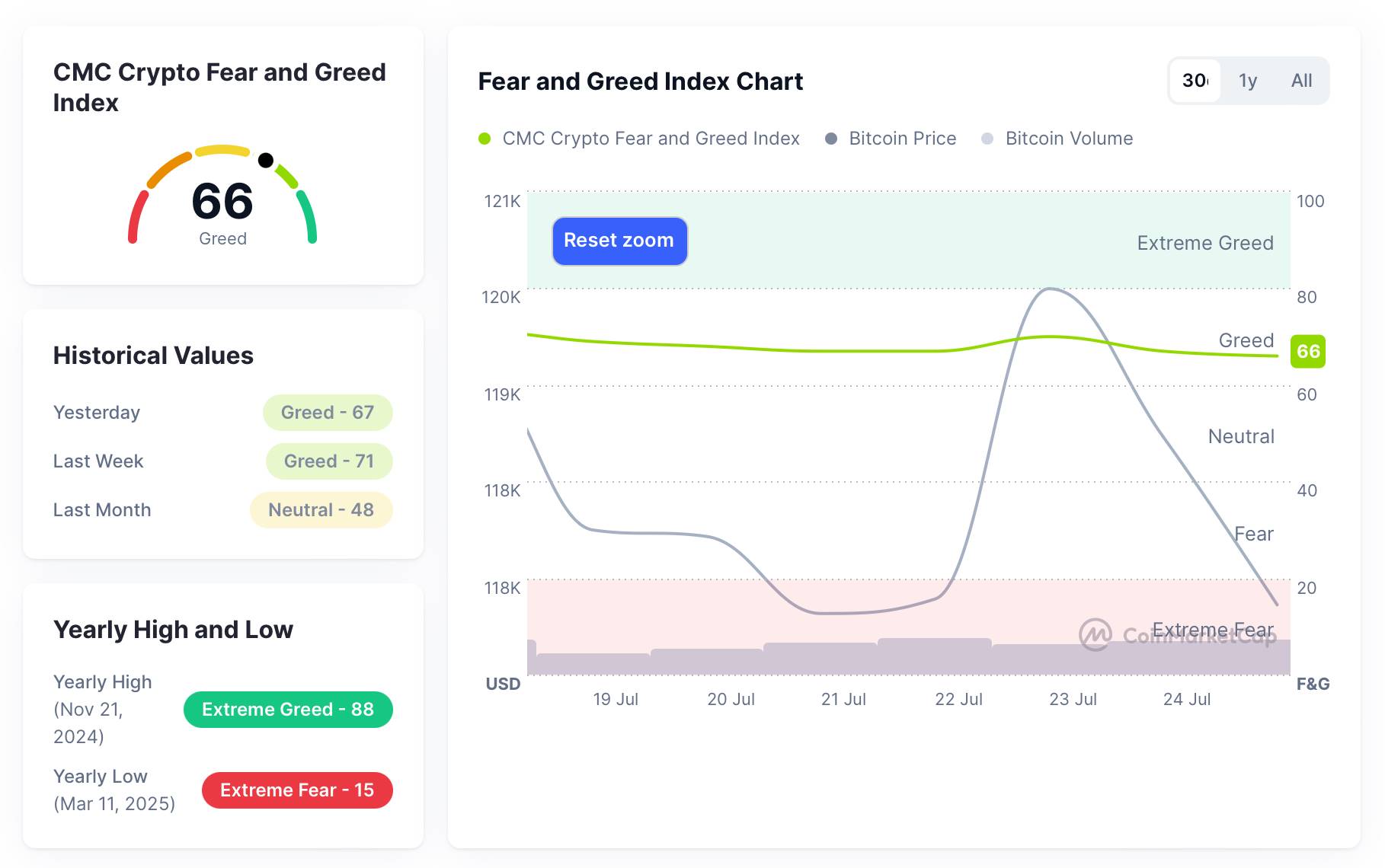
Fear and Greed Index data image
Macroeconomic Background
1. Trump's "Federal Reserve Pressure Action"
On July 24, Trump unexpectedly visited the Federal Reserve headquarters, criticizing the over $700 million renovation overspend, further pressuring Federal Reserve Chairman Powell to significantly cut interest rates and hinting at possible personnel changes.
This move was interpreted by the market as an intervention in the independence of the central bank. Although it did not trigger severe dollar volatility in the short term, it clearly increased policy uncertainty and boosted demand for safe-haven assets (such as Bitcoin).
2. Powell's Speech and Key Economic Data Combo
On July 22, Powell reiterated at a European conference that "the Federal Reserve will stick to data-driven decisions and will not be swayed by political motives," suggesting that interest rate cuts would not be influenced by current disturbances.
From July 23 to 24, various economic indicators, including existing home sales, new housing starts, manufacturing and services PMIs, and quarterly reports from about 112 companies, will be released intensively. If core inflation data unexpectedly weakens, it may reignite market expectations for interest rate cuts, guiding funds into Bitcoin.
3. China's Economic Recovery Boosts Global Risk Appetite
On July 21, China's GDP grew by 5.2% year-on-year in the second quarter, exceeding market expectations, which warmed global market risk appetite and led to capital inflows into risk assets.
At the same time, tensions in international trade eased, U.S. stocks consolidated, and funds gradually flowed into crypto assets.
4. Capital Rotation Trend: Bitcoin's Safe-Haven Role Highlights
On July 22, the latest analysis showed that the correlation between BTC and traditional stock markets (S&P, Nasdaq) has dropped to about 0.2, with funds flowing into the crypto market during stock pullbacks.
Since the beginning of July, Bitcoin has risen by 3.5%, with a total market capitalization maintained between $3.4 trillion and $4 trillion, while the weakness in U.S. stocks has provided short-term upward momentum.
5. Traditional Finance Further Embraces the Crypto Ecosystem
On July 22, JPMorgan is considering incorporating crypto assets (BTC/ETH) into its credit collateral system, marking a larger-scale institutional entry.
This shift is seen as a signal for institutional entry, helping to reduce volatility in the crypto market and enhance market depth.
6. Massive ETF Fund Inflows
As of July 23, statistics show that net inflows into U.S. spot Bitcoin ETFs have surpassed $54.8 billion by mid-July, with two consecutive days in early July seeing inflows exceeding $1 billion.
Such capital inflows provide solid price support for Bitcoin, explaining the recent upward momentum.
3. Hash Rate Changes
From July 19 to July 25, 2025, the Bitcoin network hash rate exhibited fluctuations as follows:
On July 19, the overall network hash rate showed a "rise then fall" trend, increasing from 890.76 EH/s to 1.0240 ZH/s (i.e., 1,024.0 EH/s) during the day, then gradually retreating to 833.26 EH/s by the end of the day, indicating that miners may conduct short-term power outages or maintenance after high loads. On July 20, the hash rate steadily climbed from a daily low of 795.58 EH/s to 989.33 EH/s, with a slight pullback to 909.64 EH/s during the period, but maintaining at 943.78 EH/s by the end of the day, showing an overall warming trend. On July 21, the hash rate fluctuated more dramatically, first dropping significantly to 847.81 EH/s, then quickly rebounding, reaching 975 EH/s at noon and rising to 1.0131 ZH/s in the evening, marking the day's high, indicating that miners quickly restored output after a short recovery in power or environmental conditions.
On July 22, the hash rate slightly retreated to 939.25 EH/s, then gradually climbed, reaching 992.62 EH/s, 1.0524 ZH/s, and peaking at 1.1092 ZH/s, the highest of the week. However, it could not be maintained, subsequently dropping significantly to 933.24 EH/s by the end of the day, indicating that large fluctuations may be related to intermittent online and offline operations of some mining farms. On July 23, the hash rate continued the previous day's downward trend, sharply falling to 829.70 EH/s, retreating to the low range of the week, reflecting that miners may still face operational costs or external power supply pressures. It briefly rebounded to 892.35 EH/s during the midday phase, then fell again, but the downward trend slowed. In the evening, the hash rate gradually stabilized and slowly rose to 937.62 EH/s, indicating that network computing power began to recover. On July 24, the hash rate retreated again in the morning, touching 830.78 EH/s, then began a clear upward trend, rising to a daily high of 993.70 EH/s in the afternoon. However, this level could not be effectively maintained, and it subsequently fell back to 887.72 EH/s. The overall trend shows some recovery in computing power.
From July 19 to July 25, 2025, the overall Bitcoin network hash rate exhibited a state of "initial oscillation upward, followed by a high-level retreat." In the first half of the week (July 19 to July 22), the hash rate was generally on the rise, with the low points continuously moving up, reflecting the gradual enhancement of network stability and the recovery of some large mining farms. The peak during this period occurred on July 22, reaching 1.1092 ZH/s. However, this high level did not last, followed by a significant pullback, possibly related to strategic shutdowns of some mining farms, fluctuations in electricity prices, or changes in external conditions. In the second half of the week (July 23 to July 24), the hash rate quickly dipped to the low range of the week, hitting a low of 829.70 EH/s, but then gradually stabilized and rebounded, reaching 993.70 EH/s on July 24. Although it ultimately fell back, the overall trend showed a pattern of oscillation and recovery, indicating that the network computing power has a certain recovery capability, and miners are relatively flexible in responding to market conditions.
Overall, this week's Bitcoin hash rate trend reflects the current sensitivity and flexibility of miner operations. On one hand, due to external factors such as electricity costs and climate, the operation of computing power shows strong short-term volatility; on the other hand, against the backdrop of attractive prices, the rapid recovery of computing power also indicates that miners' willingness to maintain output remains strong. If external conditions stabilize in the future, the hash rate is expected to gradually return to high ranges.
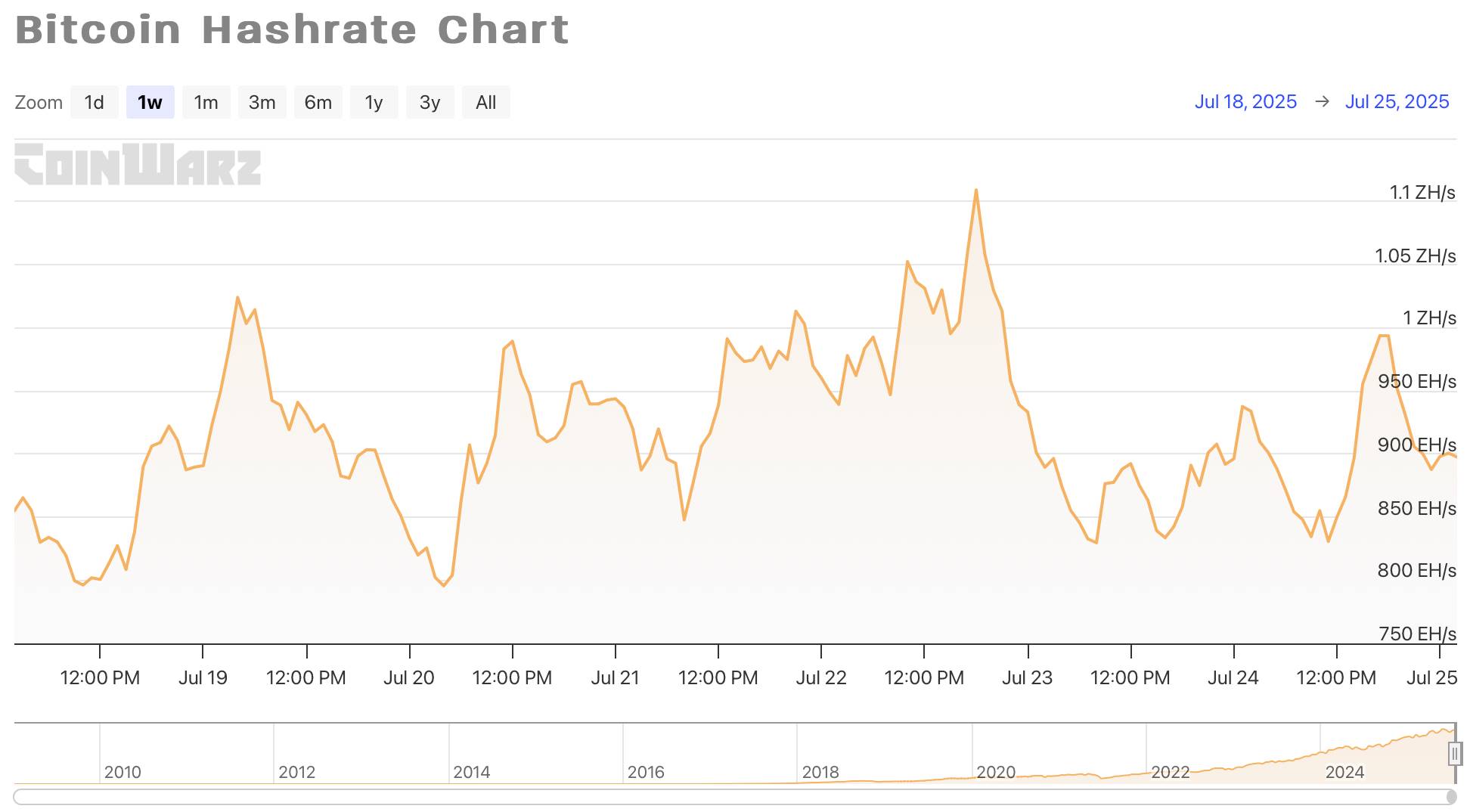
Bitcoin Network Hash Rate Data
4. Mining Revenue
According to data from YCharts, the total daily revenue of Bitcoin miners (including block rewards and transaction fees) this week is as follows: July 19: $55.14 million; July 20: $55.35 million; July 21: $55.85 million; July 22: $56.70 million; July 23: $52.38 million. Overall, the average daily revenue of miners this week fluctuated between $52 million and $57 million, showing a more stable trend compared to the previous week. Although there was a slight decline on July 23, the overall fluctuation was small, reflecting that the current market is at a relatively stable level of block generation and trading activity.
From the perspective of daily earnings per unit of computing power (Hashprice), Hashrate Index data shows that Hashprice has been relatively stable this week. As of the time of writing on July 25, Hashprice is reported at $59.65 /PH/s/day. The overall performance of Hashprice this week has been stable, showing a mild upward trend. From the trend, the low points of Hashprice are gradually rising, indicating that miners' unit output efficiency has improved, and mining returns have slightly improved.
July 23 was the peak of the week, with Hashprice reaching $60.33 /PH/s/day, showing short-term recovery momentum for mining revenue. On July 25, Hashprice was $60.10 /PH/s/day, closely following as the second-highest level of the week. Overall, the fluctuation range of Hashprice this week has been small, reflecting that the market has entered a relatively stable phase, and the structure of miner earnings has not undergone drastic changes. From a monthly perspective, the current Hashprice is at the median level of the past 30 days, and the price fluctuations over the past two weeks have converged, indicating that the market is gradually recovering from earlier severe adjustments. From a quarterly perspective, Hashprice is at a mid-high level over the past three months, which remains an acceptable range for most miners with good operational efficiency, helping to maintain the enthusiasm for computing power investment.
The stability and gradual increase of Hashprice during this period are related to the slowing growth rate of the overall network hash rate. Since the competitive pressure on the network has not significantly increased, and Bitcoin prices remain high, the unit earnings obtained by miners have shown a phase of recovery, which is conducive to enhancing the activity of mining operations in the medium to short term.
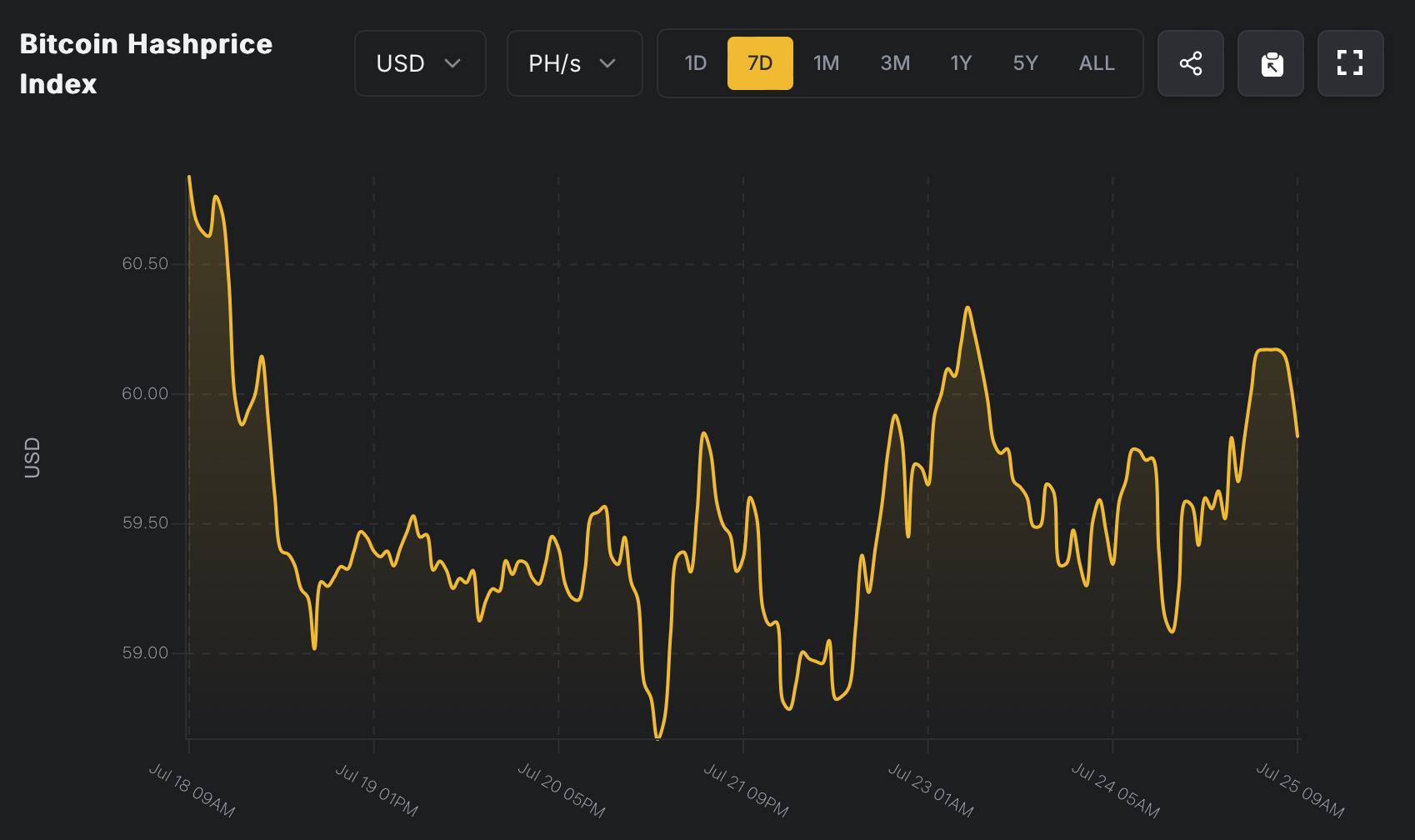
Hashprice Data
5. Energy Costs and Mining Efficiency
According to data from CloverPool, as of July 25, 2025, the total network computing power of Bitcoin has risen to 916.17 EH/s, with mining difficulty at 126.27 T. The next difficulty adjustment is expected to take place on July 26, with an increase of approximately 0.56%, raising the difficulty to an estimated 126.97 T. This phenomenon reflects that miners remain optimistic about the network's prospects, and the intensity of competition continues to rise.

Bitcoin Mining Difficulty Data
From the perspective of mining costs, according to the latest model data from MacroMicro, the average production cost as of July 20 is approximately $95,333, with a cost/spot price ratio of about 0.81 corresponding to the spot price of $117,300 on that day; the latest data from July 23 also shows a cost of about $94,905, with a spot price of approximately $118,755, resulting in a cost ratio of 0.80, maintaining an overall fluctuation in the range of 0.80–0.81. This cost ratio level means that miners can average about 20% gross profit margin, and the current Puell Multiple is at 1.38–1.39, with the value of block rewards still above the annual average level, indicating that miners' income is relatively considerable. Additionally, the daily issuance from July 19 to 24, 2025, has stabilized at 437–469 BTC, with the total market capitalization in the range of $2.33–2.39 trillion, maintaining a stable relationship between price and cost, matching supply and demand.
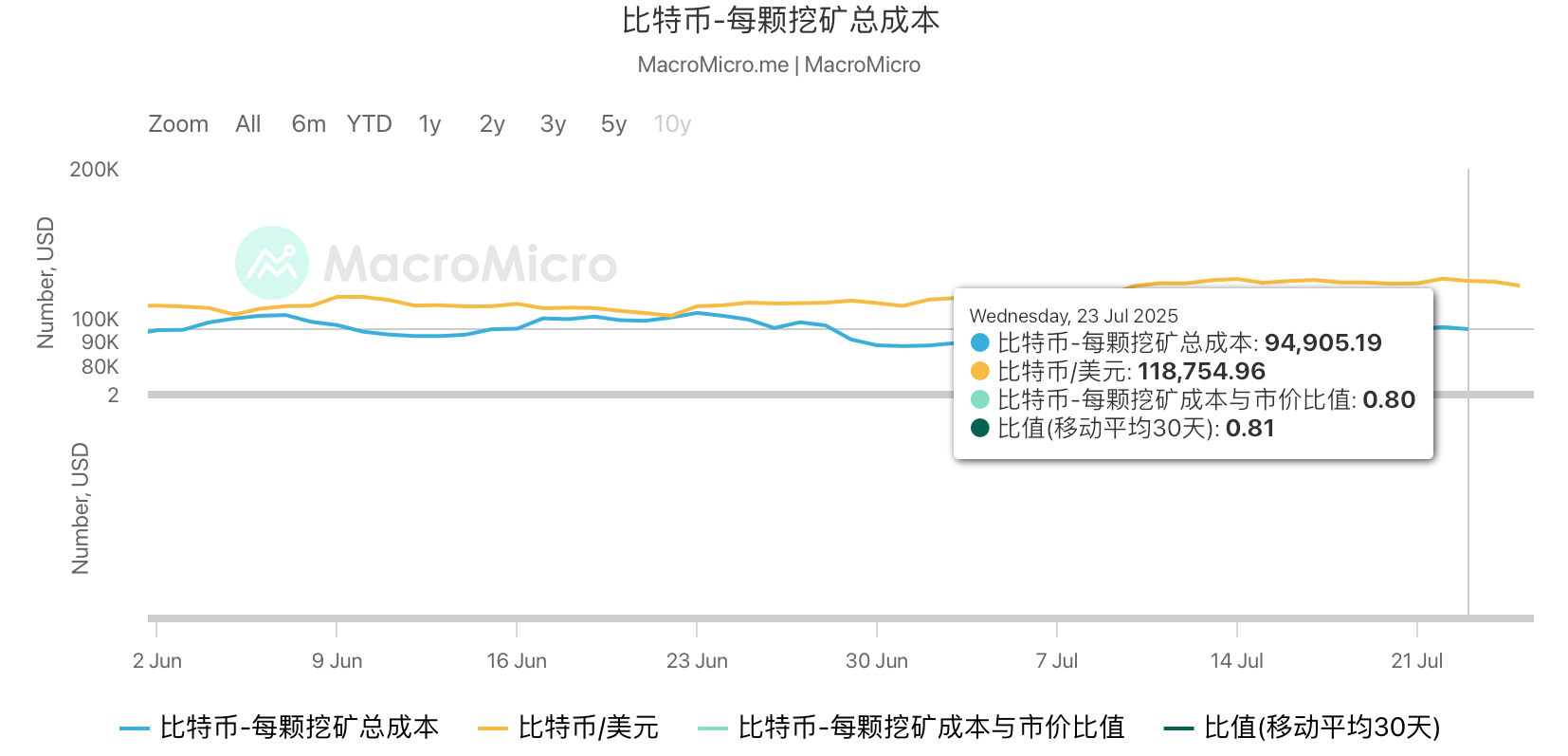
Total Mining Cost per Bitcoin Data
This week, Bitcoin mining has maintained a good profit status. Although unit production costs have risen, the high spot prices keep the mining cost - spot price ratio around 0.80, allowing miners to maintain about 20% profit margin, resulting in overall ample cash flow. The total network computing power is steadily increasing, and the expected difficulty adjustment reflects strong miner confidence and ongoing industry competition. However, with mining difficulty reaching new highs, high-energy, low-efficiency mining farms are facing elimination pressure. Future profitability will depend on Bitcoin price trends and whether miners can optimize energy efficiency or relocate to low electricity price areas. Overall, the mining industry is operating steadily in the short term, but attention should still be paid to changes in energy costs and potential risks brought about by market fluctuations.
6. Policy and Regulatory News
IMF Confirms El Salvador's Bitcoin Holdings Remain Unchanged, Purchase Behavior Complies with Agreement Commitments
On July 20, El Salvador's Minister of Finance and Central Bank President confirmed to the International Monetary Fund (IMF) that since signing the financing agreement in February 2025, the government has not purchased additional Bitcoin, and the existing Bitcoin quantity remains unchanged, with the relevant wallet addresses provided to the IMF for monitoring. On July 24, the IMF further stated that the accumulation of Bitcoin in El Salvador's strategic Bitcoin reserve fund complies with the planned conditions, and the total amount of Bitcoin in the current government wallet remains unchanged, in line with the agreement commitments. This statement contradicts President Bukele's remarks about "purchasing 1 Bitcoin daily." The IMF pointed out that the growth in Bitcoin balance only reflects internal consolidation and does not violate the terms of the agreement.

Related Images
7. Mining News
Brazilian Miners Warn: Retaliatory Tariffs from the U.S. Could Result in $1 Billion Losses
On July 22, Brazilian miners warned that if the government takes reciprocal tariff measures in response to U.S. President Trump's threat to impose a 50% tariff starting August 1, it could lead to severe economic consequences.
Raul Jungmann, head of the Brazilian Mining Association (Ibram), stated that if Trump follows through on his threat and Brazil implements such countermeasures, the mining sector could face up to $1 billion in additional costs annually. Brazilian mining executives are considering engaging in dialogue with U.S. companies to encourage the Trump administration to return to the negotiating table.
Bitcoin Mining Company Mawson Fires CEO Over Fraud Allegations
On July 22, The Miner Mag reported that Bitcoin mining and hosting company Mawson Infrastructure has fired its CEO and President Rahul Mewawalla and revoked his board seat due to violations of fiduciary duties and fraudulent behavior. Mawson has filed a lawsuit in Delaware Chancery Court seeking damages.
Mewawalla had previously received a $2.5 million bonus and 1.2 million shares of restricted stock for "high performance," with his annual salary rising to $1.2 million. In his response, he denied any wrongdoing, emphasizing that under his leadership, the company's revenue grew by 36% and gross profit increased by 35%.
Additionally, Mawson has recently been involved in a lawsuit with NYDIG and its parent company Stone Ridge over custody disputes involving over 20,000 mining machines valued at $30 million.

Related Images
Russian Officials: The State Should Confiscate Cryptocurrency from Illegal Miners
On July 23, Yevgeny Masharov, a member of the Russian Public Chamber and a policymaker, stated that authorities should be granted the power to confiscate cryptocurrency from illegal or quasi-legal Bitcoin miners. Masharov believes this proposal will deter "gray" miners by "making illegal mining unprofitable."
Masharov noted that many regions are under significant pressure on their power grids due to illegal miners, and if this proposal is accepted, regions in Russia, "especially those facing energy shortages, will breathe a sigh of relief."
8. Bitcoin News
Global Corporate Bitcoin Holdings Dynamics (This Week's Statistics)
- El Salvador (Country):
According to mempool data from July 20, El Salvador's national Bitcoin holdings have surpassed 6,200, with a current holding of 6,242.18 BTC, valued at approximately $736 million. This marks the country's continued implementation of its "Bitcoin national policy," steadily accumulating digital asset reserves.
- UK Vaultz Capital
On July 21, UK-listed company Vaultz Capital announced the purchase of an additional 20 Bitcoins, bringing its total Bitcoin holdings to 70. The company has recently begun to accelerate its investment in Bitcoin assets as part of its digital asset allocation.
- Europe The Blockchain Group
According to an official announcement on July 21, European listed company The Blockchain Group increased its holdings by 22 BTC this week, with a total investment of approximately €2.2 million. The latest statistics show that its total Bitcoin holdings have reached 1,955 BTC, with a year-to-date return of 1,373.2%, demonstrating strong investment returns.
- USA Sequans Communications
On July 21, U.S. listed company Sequans significantly increased its holdings by 1,264 Bitcoins, purchasing approximately $150 million worth. This raised its total Bitcoin holdings from 1,053 to 2,317, making it one of the largest U.S. companies to increase its holdings this week.
- USA Genius Group
On July 21, U.S. listed company Genius Group announced another purchase of 20 Bitcoins, bringing its total holdings to 200. The company has been consistently increasing its BTC holdings in recent years to enhance its asset diversification capabilities.
- Australia Monochrome (IBTC Spot ETF)
Data disclosed on July 22 shows that Australia's Monochrome's IBTC spot Bitcoin ETF had increased its BTC holdings to 954 as of July 21, with a total value of approximately AUD 175 million at the time's market price, indicating continued inflows from institutional investors into the spot Bitcoin market.
- Canada Belgravia Hartford
On July 24, an official announcement stated that Canadian company Belgravia Hartford has purchased 25 Bitcoins, bringing its total holdings to 40.8 BTC.
Public Company Bitcoin Treasury Dynamics (This Week)
- U.S. listed company Aether Holdings to raise $40 million to purchase Bitcoin
On July 19, Aether Holdings announced it would raise $40 million, with most of the funds allocated for purchasing Bitcoin as part of its financial reserve strategy. As of the time of writing, the company's market capitalization is $158 million.
- Swedish listed company H100 Group AB completes a directed share issue to invest in Bitcoin
On July 21, H100 Group AB completed a directed share issue, raising approximately $1.3 million to advance its Bitcoin treasury strategy.
- Indian listed company Jetking expands Bitcoin reserves
On July 21, Jetking's board approved a directed share issue plan to raise ₹1.15 billion, primarily for increasing Bitcoin holdings, general operations, and Bitcoin education and training.
- U.S. listed company Profusa signs a $100 million financing agreement and initiates Bitcoin reserve strategy
On July 21, Profusa (NASDAQ: PFSA) signed an equity credit agreement with Ascent Partners to raise up to $100 million for purchasing Bitcoin as a core asset.
- Trump Media Technology Group's Bitcoin reserves reach $2 billion
On July 21, Trump Media Technology Group (DJT.O) announced that its total Bitcoin reserves have reached $2 billion and will continue to acquire Bitcoin and related assets.
- K Wave Media collaborates with Galaxy Digital to advance Bitcoin strategy
On July 22, K Wave Media (NASDAQ: KWM) reached a strategic partnership with Galaxy Digital, having purchased 88 Bitcoins and secured nearly $1 billion in institutional funding support.
- Electric vehicle company Volcon makes its first purchase of 280 Bitcoins and completes a $500 million private placement
On July 22, U.S. listed company Volcon made its first purchase of 280.14 Bitcoins while completing over $500 million in private placement financing for its Bitcoin strategic deployment.
- Mexican real estate group Grupo Murano plans to establish a $10 billion Bitcoin treasury
On July 22, Grupo Murano announced it would invest $1 billion in Bitcoin and plans to build a $10 billion Bitcoin asset reserve within five years.
- Swedish company Fragbite Group makes its first Bitcoin purchase
On July 22, Fragbite Group announced its first purchase of approximately 4.3 Bitcoins, initiating its Bitcoin treasury strategy.
- Japanese textile company Kitabo plans to purchase $5.4 million in Bitcoin
On July 22, Japanese company Kitabo announced it would purchase approximately ¥800 million (about $5.4 million) in Bitcoin as part of its new financial strategy.
- Japanese listed company Metaplanet's holdings have increased 66 times in a year, firmly establishing its Bitcoin treasury strategy
On July 23, Metaplanet's CEO Simon Gerovich stated on social media that the company held only 246 Bitcoins a year ago, and its Bitcoin holdings have now increased to 16,352, a growth of 66 times. Metaplanet will firmly advance its Bitcoin treasury strategy established 15 months ago and continue to move towards the "1% club."
- Canadian listed company Matador secures $100 million in financing for Bitcoin reserve construction
On July 23, Canadian listed company Matador announced it has secured $100 million in financing to advance its Bitcoin treasury construction plan.
- Canadian listed company Planet Ventures plans to raise CAD 5 million to increase Bitcoin holdings
On July 23, Canadian listed company Planet Ventures announced plans to raise up to CAD 5 million (approximately $3.7 million) through convertible debt financing to further increase its Bitcoin holdings and strengthen its Bitcoin treasury position.
- Swedish listed company Hilbert Group reaches a $1.58 million financing agreement to increase Bitcoin holdings
On July 23, Swedish company Hilbert Group signed a structured financing agreement with LDA Capital for a total of 150 million Swedish Krona (approximately $1.58 million). This financing will be flexibly drawn over 36 months to gradually increase Bitcoin holdings. Hilbert will continue to advance its Bitcoin treasury strategy.
- Canadian listed company Sixty Six Capital increases its holdings by 16.02 Bitcoins through ETF
On July 24, Canadian listed company Sixty Six Capital announced that it has indirectly increased its holdings by 16.02 BTC through the purchase of 114,000 units of the Bitcoin ETF BTCC.B, bringing its total holdings to 148.8 BTC. The company clearly positions itself as "Bitcoin treasury + crypto investment company." In the future, it will convert ETF-equivalent BTC into spot Bitcoin holdings when feasible.
- Nativo Resources announces the adoption of Bitcoin as a financial reserve strategy.
On July 24, London-listed company Nativo Resources (LON:NTVO) announced the adoption of a digital asset fiscal policy, allocating part of its cash flow and financing to hold Bitcoin. The company believes that BTC, along with gold, can serve as a reserve asset against inflation and has partnered with Copper.co to provide custody services. The board stated that despite price volatility and regulatory risks, the company still views Bitcoin as one of its core financial tools.
- Satsuma Raises $135 Million, Sets Record for Bitcoin Treasury Financing in the UK
On July 24, Satsuma Technology successfully raised £100 million (approximately $135 million) to establish a corporate Bitcoin treasury. If the company converts all funds into BTC, it will become the second-largest Bitcoin-holding company in the UK. The current record is held by The Smarter Web Company, which holds 1,600 BTC.
- Strategy Increases Financing Scale to $2 Billion for Bitcoin Accumulation
On July 24, market news indicated that Strategy (formerly MicroStrategy) has raised its financing scale from $500 million to $2 billion for purchasing Bitcoin. Previously, on July 22, Strategy announced the launch of an IPO, issuing 5 million shares of STRC stock, with the raised funds intended for Bitcoin purchases and other corporate purposes.
Tim Draper: Macroeconomic Factors Will Diminish the Impact of Bitcoin Halving Cycles
On July 20, macroeconomic factors, including the depreciation of the U.S. dollar (USD), will weaken the impact of Bitcoin halving cycles. Since 2009, the cyclical fluctuations of the Bitcoin market's booms and busts have stemmed from these halving cycles, noted Tim Draper, founder and partner of venture capital firm Draper Associates, in an interview.
"In the next 10 to 20 years, the dollar will disappear," Draper stated during the interview. "The world is changing, and we are witnessing this process. We are in the midst of a significant leap in human civilization," he added.
Tim Draper pointed out that investors are increasingly viewing Bitcoin as a "safety valve" against poor governance, distrust in banking institutions, fiat currency inflation, and geopolitical tensions, all of which are driving global adoption of Bitcoin, a digital currency with a limited supply. The venture capital firm added:
"If Bitcoin continues to confront the dollar in the current manner, the impact of halving events may diminish, as this trend could persist for a long time. It will still be influenced by the four-year cycle to some extent, but I believe the impact will weaken."
Michael Saylor: There Are Only 10 Years Left to Acquire Bitcoin
On July 21, according to Cointelegraph, Strategy founder Michael Saylor stated, "You have 10 years to acquire Bitcoin, after which there will be no Bitcoin left for you."

Related Images
Fundstrat Co-Founder: Predicts Bitcoin Price May Exceed $1 Million in the Coming Years
On July 21, CNBC reported that Tom Lee, co-founder and managing partner of Fundstrat, stated in an interview on the "Squawk Box" program that the price of Bitcoin may exceed $1 million per coin in the coming years.
PlanB: Bitcoin Is At Least 10 Times Undervalued
On July 21, analyst PlanB posted on the X platform, "The market cap of gold is about $20 trillion, while Bitcoin's market cap is about $2 trillion. Therefore, the value of gold is 10 times that of Bitcoin. The scarcity of gold (stock-to-flow ratio) is about 60, while Bitcoin's scarcity is about 120. Thus, Bitcoin's scarcity is twice that of gold. I believe Bitcoin is at least 10 times undervalued."
Arthur Hayes: Predicts Bitcoin Will Reach $250,000 and Ethereum Will Hit $10,000 by Year-End
On July 23, according to Cointelegraph, Arthur Hayes predicted that Bitcoin's price would reach $250,000 by the end of the year, while Ethereum would touch $10,000.
Hayes pointed out that the wartime economic policies of the Trump administration are creating credit growth flowing into the cryptocurrency market, and the model of stablecoin issuers purchasing treasury bonds to finance government deficits will further drive market growth.

Related Images
Data: Only 5.3% of Bitcoin Remains Unmined, Over 7.5% Has Permanently Disappeared
On July 24, data from Curated Crypto indicated that only 5.3% of Bitcoin remains unmined. It is estimated that over 7.5% of the total Bitcoin supply has permanently disappeared from circulation due to lost wallets, forgotten private keys, or destruction.
免责声明:本文章仅代表作者个人观点,不代表本平台的立场和观点。本文章仅供信息分享,不构成对任何人的任何投资建议。用户与作者之间的任何争议,与本平台无关。如网页中刊载的文章或图片涉及侵权,请提供相关的权利证明和身份证明发送邮件到support@aicoin.com,本平台相关工作人员将会进行核查。




